

This 3D Printer Uses Glass For Ink. Is this glass half full or half empty?
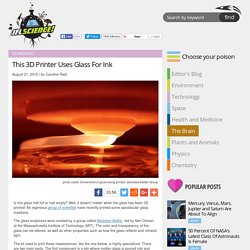
Well, it doesn't matter when the glass has been 3D printed! An ingenious group of scientists have recently printed some spectacular glass creations. The glass sculptures were created by a group called Mediated Matter, led by Neri Oxman at the Massachusetts Institute of Technology (MIT). Coming soon: 3D printable solar panels capable of powering… anything. Plastics that can be recycled for 3D printing — Perpetual Plastic Project. Okay, so we're heading towards the 2 year anniversary of Perpetual Plastic Project.

By now we have done over 40 events all over Europe to show people the possibilities of 3D printing with plastic waste. But what plastic waste is suitable for the PPP process of recycling and 3D printing? Man Constructs 3D Printed Concrete Castle. Minnesotan contractor Andrey Rudenko is now the king of his castle; his 3D-printed concrete castle, that is.
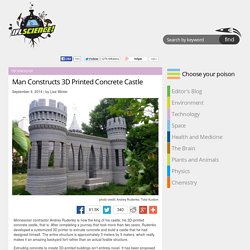
After completing a journey that took more than two years, Rudenko developed a customized 3D printer to extrude concrete and build a castle that he had designed himself. The entire structure is approximately 3 meters by 5 meters, which really makes it an amazing backyard fort rather than an actual livable structure. Extruding concrete to create 3D-printed buildings isn’t entirely novel. It has been proposed to quickly create inexpensive housing in poverty-stricken areas and even to build infrastructure on Mars before the arrival of astronauts. However, those buildings were designed to be fairly simple and lacked architectural details. Multifunctional 3d printing delta robot ZeGo launching on Monday.
April 26, 2014 The ongoing race to build the cheapest, most versatile 3D printer continues with the impending launch of the ZeGo bot, an opensource multifunctional delta linear robot.
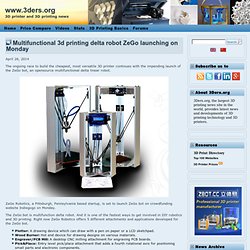
ZeGo Robotics, a Pittsburgh, Pennsylvania based startup, is set to launch ZeGo bot on crowdfunding website Indiegogo on Monday. The ZeGo bot is multifunction delta robot. And it is one of the fastest ways to get involved in DIY robotics and 3D printing. Right now ZeGo Robotics offers 5 different attachments and applications developed for the ZeGo bot. Plotter: A drawing device which can draw with a pen on paper or a LCD sketchpad.
The combination of the PCB mill and the pick and place machine allows you to do the electronic prototyping in house. The ZeGo bot was based on Rostock opensource design and co-developed with Billy Zelsnack. Voxeljet Concept: The First Continuous 3D Printer. If there ever was a major leap in the evolution of the 3D printer, the voxeljet Concept is the benchmark machine to follow.
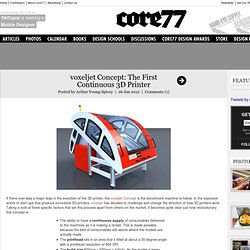
In the explosive arena of start-ups that produce innovative 3D-printers, voxeljet has decided to challenge and change the direction of how 3D printers work. Taking a look at three specific factors that set this process apart from others on the market, it becomes quite clear just how revolutionary this concept is. The ability to have a continuous supply of consumables delivered to the machines as it is making a model. 3D Printers and Rapid Prototyping. Company develops new fiber-reinforced wood, concrete ink for 3D printing. Even though 3D printing is an emerging market and technology, aside from Defense Distributed’s gun, it seems like it has hit a plateau.

You can make little or somewhat-bigger-than-little figurines, teacups and mugs that often have leaks, or fragile parts — such as gears — that you can include in a working item, but might quickly wear down. One of the things holding 3D printing back is the material used to print objects. A San Francisco-based company, Emerging Objects, has created new printing materials that aren’t just plastic, but composed of wood, concrete, and even salt. For the uninitiated, normal 3D printing is additive. Turning old plastic into 3D printer filament is greener than conventional recycling. Mar.4, 2014 3D printing technology empowers people to be both designer and manufacturer in their own home.

But, let's be honest, it is so expensive. EDAG's Genesis: The 3D printed car of the future. Of all the technologies to have emerged from the digital renaissance, additive manufacturing (3D printing) has the potential to be the most disruptive.

Yet another example of how the world of manufacturing will change will be displayed at the Geneva Motor Show this week when EDAG, the world’s largest independent engineering partner to the international mobility industry, displays an example of a printed automobile. The Genesis is more a conceptual sculpture than an automobile, but it will give you a taste of what the world's leading manufacturers might be producing a decade or two from now. View all. Work begins on the world's first 3D-printed house. Treacle-black plastic oozes from a nozzle at the bottom of a small tower in Amsterdam, depositing layer upon layer of glistening black worms in an orderly grid.
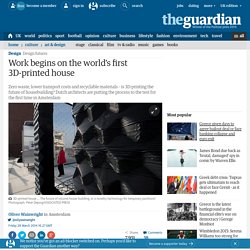
With a knot of pipes and wires rising up to a big hopper, it looks like a high-tech liquorice production line. But this could be the future of house-building, if Dus Architects have their way. On this small canal-side plot in the north of the city, dotted with twisting plastic columns and strange zig-zag building blocks, the architects have begun making what they say will be the world's first 3D-printed house. “The building industry is one of the most polluting and inefficient industries out there,” says Hedwig Heinsman of Dus. “With 3D-printing, there is zero waste, reduced transportation costs, and everything can be melted down and recycled. Carbon-fiber epoxy honeycombs mimic the material performance of balsa wood. Cambridge, Mass. – June 25, 2014 – In wind farms across North America and Europe, sleek turbines equipped with state-of-the-art technology convert wind energy into electric power.
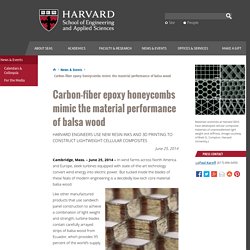
But tucked inside the blades of these feats of modern engineering is a decidedly low-tech core material: balsa wood. Optical photograph of a translucent hexagonal honeycomb printed using the baseline epoxy ink with ~1 vol.% carbon fibers added for visualization. The aligned black fibers are clearly visible within the cell walls and throughout the structure. The complete structure is 3 mm high and 30 x 40 mm in area, with cells that are 6 mm from wall to wall. (Image courtesy of Brett G. Like other manufactured products that use sandwich panel construction to achieve a combination of light weight and strength, turbine blades contain carefully arrayed strips of balsa wood from Ecuador, which provides 95 percent of the world’s supply.
Lewis and Brett G. 3D-printed composite is lighter than wood and stiffer than concrete. Reseachers at Harvard University have developed a way to 3D-print a cellular composite with record lightness and stiffness using an epoxy resin. This marks the first time that epoxy is used for 3D-printing, and the advance could lead to the development of new lightweight architectures for more efficient wind turbines, faster cars, and lighter airplanes.
View all If you take all of the materials known to man, whether natural or man-made, and observe their relative properties, you'll soon find a very clear pattern: density and strength always seem to go hand-in-hand. The very light foams are generally extremely weak, and on the other end of the spectrum, the heavy materials like steels and other metals are among the strongest we know. 3D tisk karbonových vláken - Mark One. Letošní rok bude podle dosavadního vývoje tím, kdy se na poli 3D tisku dočkáme dalších významných změn a vývoje. Technologie se přesune blíže běžným uživatelům a především přibudou další materiály a složky, z nichž bude moci tisknout. Inženýři z Mark Forg3D ukázali na konferenci SolidWorks World 2014 funkční prototyp zařízení schopného tisknout objekty z běžných materiálů, ale navíc i nylonu, sklolaminátu či uhlíkových vláken.
Mark ONE, jak se jejich výtvor jmenuje, sází na dvojici tiskových hlav a dvojici zásobníků materiálu. Speciálně byla upravena i patentovaná tisková plocha, kterou lze nyní snadno vyjmout a poté vrátit zpět s přesností vůči tiskovým hlavám na pouhých 10 mikrometrů (mikrometr = tisícina mm). 3D tisk karbonových vláken by mohli ocenit například modeláři a další kutilové pro zpevnění nejrůznějších konstrukcí. Technologie tisku FFF a CFF: Tavíme a spojujeme Jak jsme si řekli výše, právě podporované materiály budou důležitou konkurenční výhodou.
Druhou je tzv. První 3D tiskárna na světě, která tiskne karbonové kompozity, stojí jen 5000 dolarů » 3D tisk. Na konferenci SolidWorks World 2014 v San Diegu byla představena překvapivě levná 3D tiskárna, rozšiřující klasickou technologii tisku z plastového vlákna o stavbu pevných kompozitových prvků. Keramické kompozity a 3D tisk pomáhají snižovat spotřebu letadel.